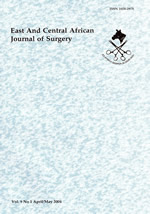
|
East and Central African Journal of Surgery
Association of Surgeons of East Africa and College of Surgeons of East Central and Southern Africa
ISSN: 1024-297X
EISSN: 1024-297X
Vol. 18, No. 1, 2013, pp. 71-77
|
 Bioline Code: js13009
Bioline Code: js13009
Full paper language: English
Document type: Research Article
Document available free of charge
|
|
|
East and Central African Journal of Surgery, Vol. 18, No. 1, 2013, pp. 71-77
| en |
Diathermy versus Scalpel incision in elective midline laparotomy: A prospective randomized controlled clinical study
Chalya, P.L.; Mchembe, M.D.; Mabula, J.B & Gilyoma, J.M.
Abstract
Background:
Skin incisions have traditionally been made using a scalpel. Diathermy, a more
recent alternative, is thought to increase the risk of infection, impair healing and decrease
cosmesis. Recent studies suggest that diathermy may offer potential advantages with respect
to blood loss, incision time and postoperative pain. The aim of this study was to compare the
efficacy and safety of surgical diathermy incisions versus conventional scalpel incisions for
midline laparotomy in our local setting with an aim to evaluate diathermy as an effective
alternative to scalpel incision.
Methods:
This was a prospective randomized clinical study which was conducted in the
surgical wards of Bugando Medical Centre between January 2010 and December 2011.
Patients were randomly assigned to two groups i.e. Group A (Scalpel group) and Group B
(Diathermy group).
Results:
A total of 214 patients were enrolled in the study. Of these, 108 patients were
randomized to Group A (Scalpel group) and 106 patients to Group B (Diathermy group). The
two groups did not differ significantly in relation to age and sex (p > 0.001). Laparotomy skin
incisions using diathermy were significantly quicker than scalpel incisions (p = 0.001). There
was significantly less blood loss in the diathermy group compared with the scalpel group (P =
0.012). The mean visual analogue scale was significantly reduced more in the diathermy
group than in Group Scalpel group patients on postoperative day 1 (p =0.001), day 2 (p =
0.011) and 3 (p =0.021) respectively. The mean amount of intramuscular analgesic
requirement was significantly less in the Diathermy group than in the Scalpel group (p=
0.021). Postoperative complication rates did not differ significantly between the Scalpel and
Diathermy groups (p = 0.243). There was no significant difference between two groups with
respect to the mean length of hospital stay (p = 0.834).
Conclusion:
We conclude that diathermy incision in elective midline laparotomy has
significant advantages compared with the scalpel because of reduced incision time, less blood
loss, reduced early postoperative pain and analgesic requirements.
|
| |
© Copyright 2013 - East and Central African Journal of Surgery
|
|
